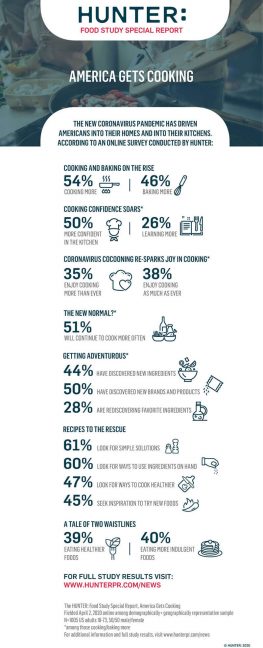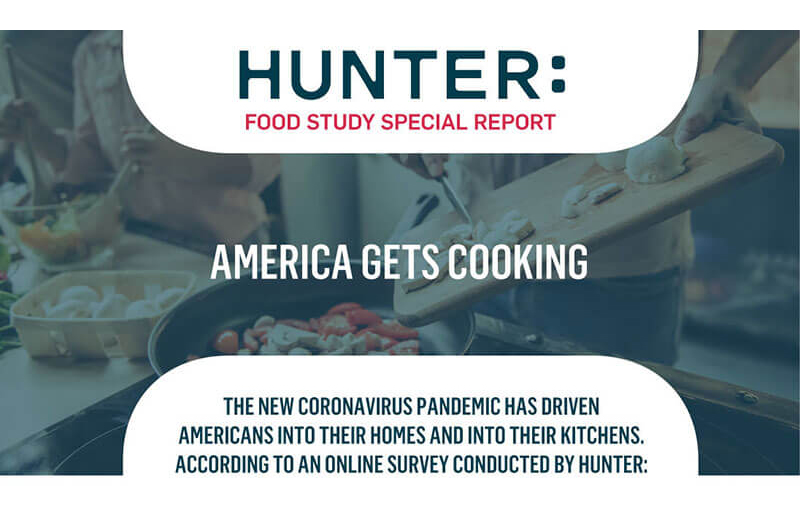Americans ordered to stay at home during the Covid-19 pandemic are being forced to find new ways to fulfill their daily responsibilities and occupy their free time. A new study released April 15—”America Gets Cooking: Food Trends During Covid-19″—offers a glimpse at how the coronavirus crisis is impacting adult American consumers’ food preferences and behaviors, as well as the potential for these new habits to result in lasting change.
Since 2003, Hunter, a food and beverage public relations and marketing communications consultancy, has commissioned an annual Food News Study to identify the top food news stories according to the opinions of Americans, as well as the impact of these stories on their behavior and top sources for information about food, recipes and nutrition. For this Hunter Food Study Special Report: America Gets Cooking, 1,005 American adults were surveyed online and asked to compare their cooking and eating habits now vs. prior to Covid-19, and share resulting changes in their cooking confidence and enjoyment, ingredients, recipe usage, food waste and more.
Top findings include:
- With home cooking and baking on the rise, confidence in the kitchen and the joy in cooking soar: The Hunter Food Study Special Report: America Gets Cooking confirms statistically that Americans are cooking and baking more now, with over half of consumers reporting they are cooking more (54 percent), and almost as many baking more (46 percent). While use of mail-ordered prepared meals and meal kits (22 percent) and ordering takeout and delivery (30 percent) are also increasing among some consumers, this is being offset by decreases in these behaviors by others (38 percent and 28 percent, respectively). A total of three-quarters (75 percent) of all American adults who are cooking more report that they are more confident in the kitchen (50 percent) or learning more about cooking and starting to build more confidence (26 percent). Not merely a chore, a total of 73 percent are enjoying it more (35 percent) or as much as they did before (38 percent).
- Americans become more adventurous and creative in the kitchen: Many of those surveyed have discovered new ingredients (38 percent) and new brands (45 percent) and are rediscovering ingredients they have not used in a long time (24 percent). Meanwhile, the consumers who claimed to be cooking more often are embracing these new habits even more enthusiastically (44 percent, 50 percent and 28 percent, respectively). Creativity abounds, with roughly one-third (34 percent) of all adults searching for more recipes and meal prepping (31 percent). Top recipes consumers are searching for are simple, practical meal solutions (61 percent) and ways to use up current ingredients (60 percent), although almost half of consumers are also looking for ways to cook healthier (47 percent) and inspiration to try new foods (45 percent). More than one-third (35 percent) of recipe users are searching for a cooking project and inspiration to learn new techniques.
- Households are wasting less food with help from recipes designed to use ingredients on hand: The Hunter Food Study Special Report: America Gets Cooking found that 57 percent of Americans are wasting less food than before the coronavirus crisis, with 60 percent of all adults polled reporting that they are looking for recipes to use the ingredients they have on hand in their pantry or refrigerator. And where are they finding these recipes? Top sources include websites (66 percent), social media (58 percent) and family and friends (52 percent), with Facebook leading the pack as the preferred social platform for recipes, for all but Gen Z.
- Americans split on eating healthier and eating more indulgent and comfort foods: Almost identical numbers of Americans are reporting that they are eating healthier foods (39 percent) as those turning more to indulgent and comfort foods (40 percent). Alcohol beverage consumption remains relatively the same, with equal portions of consumers drinking more wine/beer/spirits (29 percent) as drinking less (25 percent), and the majority holding steady (46 percent) drinking the same amount as they were before the coronavirus crisis. Those drinking more profile to 25-34 (33 percent) and in higher-income households (38 percent in HH with an income of $100K). Meanwhile snacking throughout the day is at an all-time high, especially in households with children, with half (50 percent) reporting they are snacking more than before.
- The new normal: cooking practices impacted long term: Importantly, among the Americans who are cooking more, more than half (51 percent) reported that they will continue to do so when the coronavirus crisis comes to an end. Top motivators include: cooking at home more often saves money (58 percent), cooking helps them to eat healthier (52 percent), trying new recipes (50 percent) and they find cooking relaxing (50 percent).
“The study results confirm many of our suspicions and certainly corroborate many of the sales trends we are seeing in the marketplace,” stated Heddy DeMaria, chief insights officer at Hunter. “We have long regarded Americans as consummate optimists. When the going gets tough, they find a way to prevail and, in this case, they are choosing to redirect their energy and creativity to the kitchen, not only finding joy in the process of cooking but also in the benefits that come from it.”
For the full Hunter Food Study Special Report: America Gets Cooking and additional information about the annual Hunter Food News Study, visit here.


The COVID-19 pandemic will forever change our eating habits and this article is evidence of this fact. As it is, a considerable share of millennials and Gen Z population were embracing the vegetarian and vegan lifestyle before the health crisis. This trend might see a huge surge in the near future. In these circumstances, plant-based protein and meat alternatives could be the next big thing. Even chains like McDonald’s and Wendy’s may soon start experimenting with this clean technology. It’s important for restaurants to keep track of the changing customer food habits during this time. This article here might help put more light on the current food preferences of Americans. https://bit.ly/3bcisyb